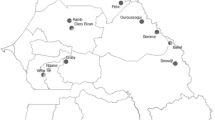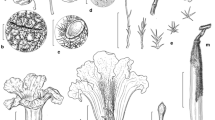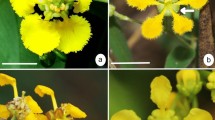Abstract
Polyploidy is the most common chromosomal mechanism involved in the evolution of plants. However, the emergence of polyploid individuals does not guarantee the establishment of a new lineage, and the relationship between polyploidy and reproductive biology is therefore relevant. Libidibia ferrea is a legume tree that has diploid and tetraploid populations. In this work we analyse the reproductive biology of the species to verify the degree of reproductive isolation between the two cytotypes. Observations on phenology, floral morphology, biology, and visitors, breeding system, reproductive success and reproductive isolation were made for both cytotypes in two municipalities of northeastern Brazil. Cytotypes differed for all morphometric parameters analysed, with tetraploids exhibiting higher mean values than diploids. Both cytotypes had the same effective pollinators (native bees from the genera Centris and Xylocopa, and the introduced Apis mellifera). However, since stamens of diploids and tetraploids were of different size, it is possible that spatial separation occurs when pollen of each cytotype is deposited on a bee’s body. Diploids were self-incompatible (ISI = 0) and exhibited high fruit-set after intraploidy crossing (20 %), whereas tetraploids were self-compatible (ISI = 0.47) and set only 3.9 % of fruits after intraploidy crossing. Both cytotypes showed low fruit- and seed-set under natural conditions, and there was no fruit-set after crosses between them. Data are discussed in relation to the establishment of polyploids, to the pattern of distribution of the species and to the taxonomic implications. The cytotypes of L. ferrea should be considered as distinct species, since they are reproductively isolated from each other.



Similar content being viewed by others
References
Alexander MP (1980) A versatile stain for pollen, fungi, yeast, and bacteria. Stain Technol 55:13–18
Araújo-Filho JC, Burgos N, Lopes OF et al (2000) Levantamento de reconhecimento de baixa e média intensidade dos solos do Estado de Pernambuco. Boletim de Pesquisa 11. Embrapa Solos, Rio de Janeiro
Arroyo MTK (1981) Breeding systems and pollination biology in Leguminosae. In: Polhill RM, Raven PH (eds) Advances in legume systematics, Part 2. Royal Botanic Gardens, Kew, pp 723–769
Barringer BC (2007) Polyploidy and self-fertilization in flowering plants. Am J Bot 94:1527–1533
Barros e Silva AE, Guerra M (2010) The meaning of DAPI bands observed after C-banding and FISH procedures. Biotech Histochem 85:115–125
Bawa KS, Webb CJ (1984) Flower, fruit and seed abortion in tropical forest trees: implications for the evolution of paternal and maternal reproductive patterns. Am J Bot 71:736–751
Beltrão GTA, Guerra M (1990) Citogenética de angiospermas coletadas em Pernambuco—III. Ciência e Cultura 42:839–845
Borges LA, Sobrinho MS, Lopes AV (2009) Phenology, pollination, and breeding system of the threatened tree Caesalpinia echinata Lam. (Fabaceae), and a review of studies on the reproductive biology in the genus. Flora 204:111–130
Faegri K, Pijl L (1979) The principles of pollination ecology. Pergamon Press, London
Fawcett JA, Van de Peer Y (2010) Angiosperm polyploids and their road to evolutionary success. Trends Evol Biol 2:16–21
Felber F (1991) Establishment of a tetraploid cytotype in a diploid population: Effect of relative fitness of the cytotypes. J Evolution Biol 4:195–207
Fowler NL, Levin DA (1984) Ecological constraints on the establishment of a novel polyploid in competition with its diploid progenitor. Am Nat 124:703–711
Gibbs PE, Lewis GP, Lughadha EN (1999) Fruit-set induced changes in the sex of flowers in Caesalpinia calycina (Leguminosae). Plant Biol 1:665–669
Guerra M (2008) Chromosome numbers in plant cytotaxonomy: concepts and implications. Cytogenet Genome Res 120:339–350
Husband BC (2000) Constraints on polyploid evolution: a test of the minority cytotype exclusion principle. P Roy Soc Lond B Bio 267:217–223
Husband BC, Schemske DW (2000) Ecological mechanisms of reproductive isolation between diploid and tetraploid Chamerion angustifolium. J Ecol 88:689–701
Husband BC, Ozimec B, Martin SL, Pollock L (2008) Mating consequences of polyploid evolution in flowering plants: current trends and insights from synthetic polyploids. Int J Plant Sci 169:195–206
Jackson RC (1976) Evolution and systematic significance of polyploidy. Annu Rev Ecol Syst 7:209–234
Jiao Y, Wickett NJ, Ayyampalayam S et al (2011) Ancestral polyploidy in seed plants and angiosperms. Nature 473:97–100
LAMEPE (Laboratório de Meteorologia de Pernambuco) (2010) Dados de chuvas e temperaturas por município. http://www.itep.br/LAMEPE.asp. 19 June 2010
Leite AV, Machado IC (2009) Biologia reprodutiva da “catingueira” (Caesalpinia pyramidalis Tul., Leguminosae-Caesalpinioideae), uma espécie endêmica da Caatinga. Rev Bras Bot 32:79–88
Levin DA (1975) Minority cytotype exclusion in local plant populations. Taxon 24:35–43
Levin DA (1983) Polyploidy and novelty in flowering plants. Am Nat 122:1–25
Levin DA (2002) The role of chromosomal change in plant evolution. Oxford University Press, Oxford
Lewis GP (2005) Caesalpinieae. In: Lewis G, Schrire B, Mackinder B, Lock M (eds) Legumes of the World. Royal Botanic Gardens, Kew, pp 127–161
Lewis G, Gibbs P (1999) Reproductive biology of Caesalpinia calycina and C. pluviosa (Leguminosae) of the caatinga of north-eastern Brazil. Plant Syst Evol 217:43–53
Lewis GP, Simpson BB, Neff JL (2000) Progress in understanding the reproductive biology of the Caesalpinioideae (Leguminosae). In: Herendeen PS, Bruneau A (eds) Advances in legume systematics, vol 9. Royal Botanic Gardens, Kew, pp 65–78
Masterson J (1994) Stomatal size in fossil plants: evidence for polyploidy in majority of angiosperms. Science 264:421–424
Miller JS, Venable DL (2000) Polyploidy and the evolution of gender dimorphism in plants. Science 289:2335–2338
Owens SJ (1989) Stigma, style, pollen, and the pollen–stigma interaction in Caesalpinioideae. In: Stirton CH, Zarucchi JL (eds) Advances in legume biology, monographs of systematic botany of the Missouri Botanical Garden, vol 29. Missouri Botanical Garden, Saint Louis, pp 1103–1126
Queiroz LP (2009) Leguminosas da Caatinga. Editora da Universidade Estadual de Feira de Santana, Feira de Santana
Ramsey J, Schemske DW (1998) Pathways, mechanisms, and rates of polyploidy formation in flowering plants. Annu Rev Ecol Syst 29:467–501
Rizzini CT, Mattos-Filho A (1968) Espécies novas da flora brasileira. An Acad Bras Cien 40:231–235
Rodríguez DJ (1996) A model for the establishment of polyploidy in plants. Am Nat 147:33–46
Segraves KA, Thompson JN (1999) Plant polyploidy and pollination: floral traits and insect visits to diploid and tetraploid Heuchera grossulariifolia. Evolution 53:1114–1127
Sokal RR, Rohlf FJ (1995) Biometry—the principles and practice of statistics in biological research. W. H. Freeman and Company, New York
Soltis DE, Soltis PS, Schemske DW, Hancock JF, Thompson JN, Husband BC, Judd WS (2007) Autopolyploidy in angiosperms: have we grossly underestimated the number of species? Taxon 56:13–30
Stebbins GL (1940) The significance of polyploidy in plant evolution. Am Nat 74:54–66
Thompson JD, Lumaret R (1992) The evolutionary dynamics of polyploid plants: origins, establishment, and persistence. Trends Ecol Evol 7:302–307
Vogel S (1990) Radiacion adaptativa del sindrome floral en las familias neotropicales. Boletin de la Academia Nacional de Ciencias, Cordoba 59:5–30
Wiens D, Calvin CL, Wilson CA, Davern CI, Frank D, Seavey SR (1987) Reproductive success, spontaneous embryo abortion, and genetic load in flowering plants. Oecologia 71:501–509
Zapata TR, Arroyo MTK (1978) Plant reproductive ecology of a secondary deciduous tropical forest in Venezuela. Biotropica 10:221–230
Acknowledgments
We thank Mrs. Dodôri, Mr. Antônio and Mr. Edisío for permission to develop the study on their properties; G. Jones, K. Demétrio and S. Soares for help in field work; E. Ribeiro and R. Pires for help in laboratory analyses; D. Coelho for identifying the bees; M. Meiado for help with statistical analyses. Financial support was provided by Coordenação de Aperfeiçoamento de Pessoal de Nível Superior-Capes (PhD Fellowship to L. Souza) and Conselho Nacional de Desenvolvimento Científico e Tecnológico-CNPq [PhD Fellowship to L. Borges, Research Grant to I. Machado, M. Guerra and A. Lopes, and financial support (CNPq grant no. 567739/2008-2) to A. Lopes].
Author information
Authors and Affiliations
Corresponding author
Rights and permissions
About this article
Cite this article
Borges, L.A., Souza, L.G.R., Guerra, M. et al. Reproductive isolation between diploid and tetraploid cytotypes of Libidibia ferrea (= Caesalpinia ferrea) (Leguminosae): ecological and taxonomic implications. Plant Syst Evol 298, 1371–1381 (2012). https://doi.org/10.1007/s00606-012-0643-3
Received:
Accepted:
Published:
Issue Date:
DOI: https://doi.org/10.1007/s00606-012-0643-3




